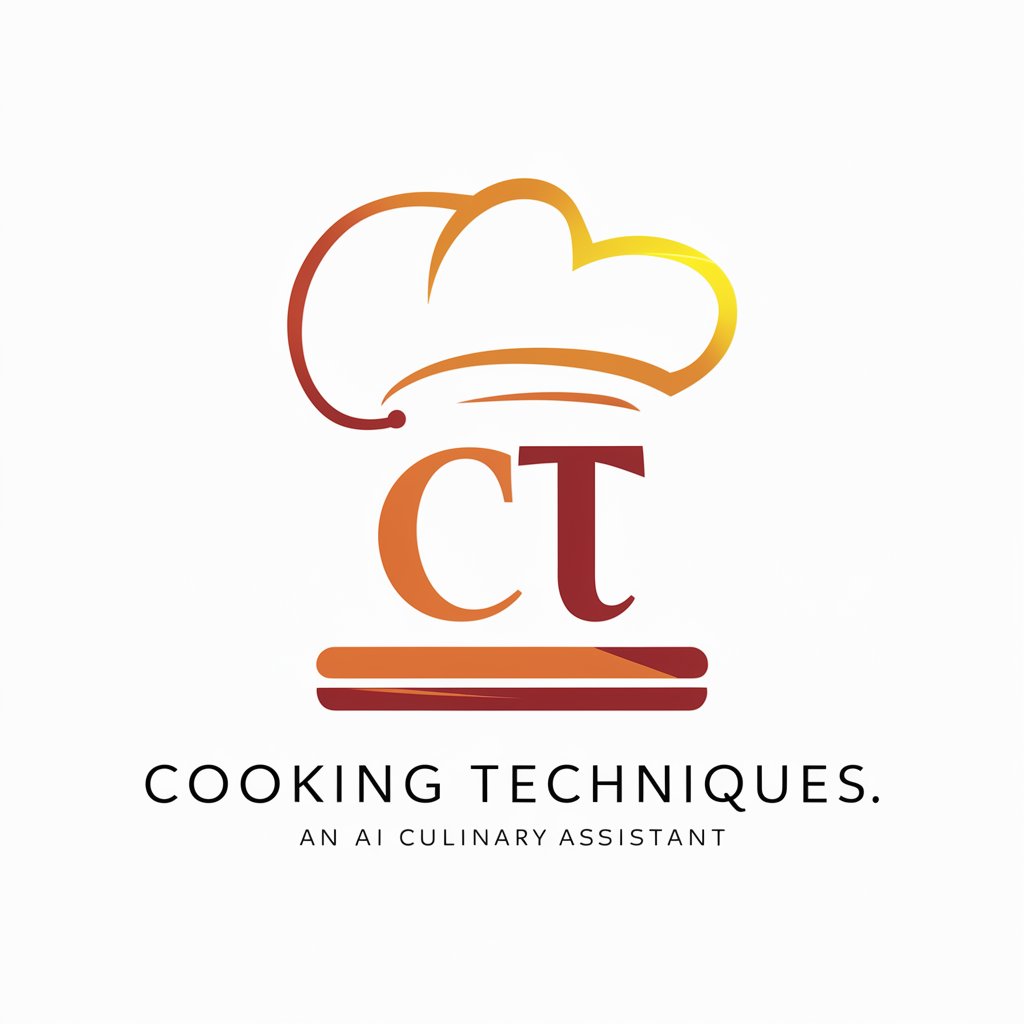Cooking Techniques - Cooking Skill Improvement

Hello! Ready to elevate your cooking skills?
AI-powered Culinary Mastery
What cooking techniques are you looking to improve?
Can you tell me about your current cooking skill level?
Are there specific dishes or cuisines you're interested in mastering?
Do you need help with any particular kitchen tools or ingredients?
Get Embed Code
Overview of Cooking Techniques GPT
Cooking Techniques GPT is a specialized AI model designed to assist individuals in their culinary endeavors. Its primary purpose is to provide expert guidance on various cooking methods, from basic to advanced. This includes offering step-by-step instructions on cooking techniques, safety and hygiene tips, ingredient and tool recommendations, troubleshooting advice for common kitchen mishaps, and insights on flavoring and seasoning. The model is equipped to tailor advice based on the user's skill level, from beginners learning to chop vegetables to experienced cooks mastering complex sauces. Powered by ChatGPT-4o。

Key Functions of Cooking Techniques GPT
Basic Technique Explanation
Example
Guiding a beginner on how to properly pan-fry a chicken breast.
Scenario
A user new to cooking wants to learn how to cook chicken without drying it out. The GPT provides step-by-step instructions on pan-frying, including heat management and internal temperature guidelines.
Safety and Hygiene Tips
Example
Advising on the safe handling of raw meats to prevent cross-contamination.
Scenario
A user preparing a meal with both meat and vegetables is unsure how to handle these ingredients safely. The GPT offers advice on separate cutting boards, proper washing, and cooking temperatures.
Ingredient and Tool Guidance
Example
Recommending the best type of knife for chopping different vegetables.
Scenario
A user is setting up their kitchen and seeks advice on essential tools. The GPT suggests various knives and their purposes, like a chef's knife for versatile cutting and a paring knife for delicate tasks.
Troubleshooting Common Issues
Example
Solving the problem of lumpy sauces.
Scenario
A user is frustrated with their homemade bechamel sauce turning lumpy. The GPT provides tips on temperature control and whisking techniques to achieve a smooth consistency.
Flavor and Seasoning Tips
Example
Teaching how to balance flavors in a dish.
Scenario
A user wants to improve the taste of their dishes. The GPT offers advice on using acids, salts, and herbs to enhance and balance flavors in cooking.
Encouraging Experimentation
Example
Inspiring creative use of spices in traditional recipes.
Scenario
A user is bored with their regular meals and seeks new ideas. The GPT suggests experimenting with different spices and herbs to add a unique twist to familiar recipes.
Target User Groups for Cooking Techniques GPT
Beginner Cooks
Individuals new to cooking who require basic guidance on techniques, safety, and simple recipes. They benefit from foundational instructions and confidence-building tips.
Home Cooking Enthusiasts
Experienced home cooks looking to refine their skills, learn new techniques, or troubleshoot specific issues in their culinary practice.
Culinary Students
Students in culinary programs seeking supplemental information and practice tips outside their formal education.
Food Bloggers and Content Creators
Individuals creating culinary content who need inspiration and technical advice to develop unique recipes and cooking methods.

How to Use Cooking Techniques
Start with a Free Trial
Begin by accessing a free trial at yeschat.ai, enabling exploration without the need for signing in or subscribing to ChatGPT Plus.
Identify Your Skill Level
Determine your current cooking skill level and the specific techniques you wish to learn or improve, such as knife skills, baking, or sauce making.
Explore Techniques
Navigate through the available cooking techniques. Use the search function or browse categories to find the technique you're interested in.
Practice and Experiment
Apply the techniques in your cooking practices. Experiment with different ingredients and recipes to enhance your skills and confidence.
Seek Further Guidance
For advanced techniques or troubleshooting, utilize the tool's Q&A feature to ask specific questions or seek advice on common cooking challenges.
Try other advanced and practical GPTs
Decodable Press
Empowering early reading with AI

Dream Weaver AR Plus
Unlock Your Dreams with AI-Powered Insights

Book Expert
Empowering Readers with AI-driven Literary Insights

KarmicSEOWriterGPT
Elevate Your SEO Game with AI

EconoBot
Decoding Microeconomics with AI

Trợ Lý Mi Mi
Empowering Creativity with AI

AI 생성형 멘토
Empowering AI Exploration with Personalized Mentorship

EBook GPT
Revolutionize Your Reading with AI-Powered E-Books

Myth Weaver
Craft and Share Mythological Worlds

Editorial Assistant
Enhance Your Writing with AI Precision

Blog500
Crafting SEO-Optimized Content with AI

PsychologyGPT
Empowering insights with AI in psychology

FAQs on Cooking Techniques
How do I choose the right knife for chopping vegetables?
Selecting the right knife depends on the vegetable's size and hardness. A chef's knife is versatile for most vegetables, while a paring knife is better for smaller, delicate tasks. Ensure the knife is sharp for safety and efficiency.
What's the best way to ensure meat is cooked safely?
Use a meat thermometer to check the internal temperature. Different meats have specific safe temperatures: 165°F for poultry, 145°F for pork and beef steaks, and 160°F for ground beef.
Can you give tips for making smooth sauces?
Start with a roux (equal parts fat and flour) as a base. Add liquid gradually while whisking constantly to prevent lumps. For cream-based sauces, low and slow heating helps avoid separation.
How can I prevent my pasta from sticking together?
Use plenty of water to allow the pasta room to move, and add salt for flavor. Stir occasionally during the first few minutes of cooking. Do not add oil to the water, as it can prevent sauce from adhering to the pasta.
What are the basic principles of flavor balancing in a dish?
Balancing flavors involves adjusting the elements of sweet, sour, salty, and bitter. Use acids like vinegar or lemon juice to brighten dishes, sweetness to balance acidity, and salt to enhance overall flavor. Bitterness can add depth and contrast.
